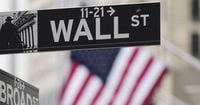As of April 3, 2025, U.S. stock index futures are facing a significant downturn, reflecting growing concerns over economic policies and international trade tensions. The NASDAQ 100 futures have plummeted by 4%, while Dow futures have dropped by more than 900 points, indicating a turbulent start to trading in the U.S. markets.
At 07:16 Tokyo time, the Dow Average Futures for June are reported at 41,553.00, down 939.00 points or 2.21%. The S&P 500 Futures are at 5,520.00, showing a decrease of 192.25 points or 3.37%. Meanwhile, the NASDAQ 100 Futures stand at 18,940.50, down 817.50 points or 4.14%. This drastic decline in futures is a direct response to recent developments in U.S. trade policy.
On April 2, 2025, President Donald Trump announced the introduction of 'mutual tariffs' on imports from various countries, which has sent shockwaves through financial markets. The basic tariff rate of 10% is set to take effect at 0:01 AM U.S. Eastern Time on April 5, 2025, with additional country-specific tariffs launching at 0:01 AM on April 9, 2025. This announcement led to a temporary drop of over 1,000 points in the Dow Jones Industrial Average futures, as major technology and automotive stocks experienced substantial declines in after-hours trading.
According to reports, the mutual tariffs applied to China will total 34%. U.S. Treasury Secretary Bessent clarified in an interview with Bloomberg Television that when combined with the existing 20% tariff already in place, the total tax rate on imports from China will rise to 54%. This escalation in tariffs is indicative of the ongoing tensions between the U.S. and China, raising fears of a further intensification of the trade war.
In response to these developments, the yen exchange rate against the dollar temporarily rose to the 148 yen level, reflecting a flight to safety among investors. The Dow mini futures for June delivery also mirrored these concerns as they showed significant volatility.
Market analysts suggest that the implications of these tariffs could have widespread effects on the U.S. economy and corporate performance, particularly for companies reliant on imports. The uncertainty surrounding trade relations is likely to contribute to a risk-off sentiment among investors, leading to further selling pressure in the stock market.
The Hong Kong stock market is also expected to start with a selling trend, influenced by the U.S. market's downturn. Investors in Asia are bracing for potential fallout from the newly announced tariffs, which may prompt similar reactions across global markets.
As the situation unfolds, the focus will remain on how the affected countries respond to these tariffs. China is expected to discuss countermeasures, which could further escalate the situation. The potential for retaliatory actions adds another layer of complexity to an already fraught economic landscape.
In summary, the recent announcements regarding mutual tariffs have triggered a significant downturn in U.S. stock index futures, reflecting heightened uncertainty and risk aversion among investors. As the market reacts to these developments, all eyes will be on the unfolding trade dynamics between the U.S. and its global partners.







